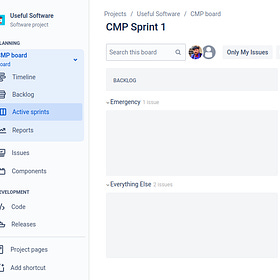Using Quantified Tasks in your Issue Tracker
Quantified Tasks is a fairly new process, and is not officially supported by any task trackers that we are aware of. However, it is easy enough to integrate. Here's a few strategies to consider.
Task Types and Fields
In this document, a Task may refer to any single work item, including a Story, Issue, Bug, Feature, or Task. Each Task must support the following fields (more details later in article):
Assignee,
Impact (1-5 drop-down),
Gravity (1-5 drop-down), likely maps to built-in Urgency/Priority field,
Priority (1-5), likely maps to Status,
Distance (1-5 drop-down),
Friction (1-5 drop-down),
Relativity (1-5 drop-down),
Energy Points (numeric), likely maps to Story Points.
Issues (a.k.a. bugs) should additionally have the following fields:
Origin (1-5 drop-down),
Caught (1-5 drop-down),
Volatility (numeric).
Subtasks rarely have any of the above.
Epics should only have the following:
Impact (1-5 drop-down); optionally, you can call this Epic Impact if necessary,
Gravity (1-5 drop-down).
Priority = Status
Priority maps to Kanban columns or the status field in most trackers. If you can edit the names of the statuses, we recommend using something like the following:
Backlog (pT-p1). You may also hide these tasks from your board.
Next Sprint (p2)
Next/Selected for Development (p3)
Now/In Progress (p4-p5)
Done
You should add a flag or label for “Emergency (p5)” to call those Tasks out from the p4 Tasks in the Now column.
Impact
The Impact field should be a custom drop-down field, as Impact is distinct from Gravity (discussed below). Be sure to add this field to both Tasks and Epics.
If you like, you may define a separate Epic Impact field for Epics.
Gravity = Urgency/Priority
The "urgency" or "priority" field on most trackers maps to the concept of Gravity. (Yes, this is confusing until you're used to it.) If you can edit the names of the urgency or priority options, we recommend the following:
g5: Highest/Critical
g4: High
g3: Medium
g2: Low
g1: Lowest/Trivial
gT: (No Value)
If you're using Jira, you may already have five possible values under their "Priority" field that you can equate to Gravity scores.
Distance, Friction, and Relativity
If you have tags, labels, or custom fields, add the five values for each of these three measures. These should be added to Tasks, but not Epics.
If you cannot add custom fields, you should type out the full formula for your Energy Points at the top of each task description. For example, (d3 + f2) * r2 = 10 might appear in your description, while just 10 goes in the Story Points field.
Jira, Trello, and Phorge/Phabricator (among others) have custom fields on tasks, so add fields for Distance, Friction, and Relativity.
GitHub and GitLab (among others) support arbitrary labels. These should look like
d3: Half Sprintorf4: Trailfor easy reading and quick adding.
Energy Points <-> Story Points
The Energy Points score belongs in the Story Points field, which most trackers have. For example, Jira and Phorge have Story Points, while GitLab Premium has Weight.
Issue trackers with automation can be configured to calculate Energy Points automatically from Distance, Friction, and Relativity.
Stability Measures
Origin and Caught are best specified with custom fields, and Volatility with a custom numeric field. Barring this, include them in the description instead.
Automation can be used to auto-populate a custom numeric Volatility field from Origin, Caught, and Impact.
Tracker-Specific Patterns
Quantified Tasks in Jira
Jira is by and away one of the most popular issue tracking systems in software engineering. It has decent support for Quantified Tasks via custom fields and automation. You can set up Quantified Tasks with either company-managed projects (strongly suggested!) or team-managed projects.
Quantified Tasks in Monday.com
Monday.com is an excellent option for teams that want to use Quantified Tasks, as it offers great customization and automation tools. We recommend using the Table with Tasks. One of the best advantages of Monday.com for Quantified Tasks is the fact that averages and sums are automatically shown for each group of Tasks.
Share Your Usage Patterns!
If you have any patterns you'd like to share, please comment!
Additionally, if you are a designer or developer on an issue tracker, and you add support for Quantified Tasks, let us know! We want to spread the word.





